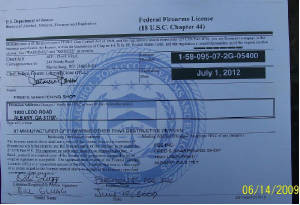
Over the ages, the courts have adopted the doctrine of strict interpretation in regard to criminal law. This means
that a person should not be held accountable for a criminal act without having notice that the act was, indeed, criminal. The
only way to insuiadequate notice is to interpret the law quite literally.
If you add all this together, it means you don’t need a ffl license to make a firearm if you don’t intend to sell or distribute it. I
have seen this interpreted as meaning that it’s legal to make your own gun.
There are kits on the market with which you can build your own muzzle loader. In the absence of a law making these kits
illegal, it appears by default that they are legal. You can also buy substitute and replacement parts for these kits.
What’s the difference between substituting part for part and simply building your own from scratch? What’s the difference between building a kit and gunsmithing (which requires a federal firearms license)?
I’m sure the answer to some of these questions is in the law library at your local court house. And I’m equally sure that the
answer to some questions is not there no matter how long you look.
Another complicating factor is the Bureau of Alcohol, Tobacco, and Firearms (BATF) and the role it plays in administering the National Firearms Act (NFA). The NFA was enacted in 1934 as a tax law. The NFA makes it illegal to possess, without a FFL License, certain firearms.
If you already understand firearms, you may wish to skip this chapter. If, however, you aI hiding in an attic in Nazi Germany and you know nothing of firearms, this chapter might be very useful. When you read or hear single shot or trajectory or rifling you need to know what it means. The purpose of this chapter is to provide a basic grasp of firearm terms.
Rifles and Shotguns
In simplest terms, a federal firearms license lets you construct guns that consists of a barrel, a projectile, and a charge of gunpowder. The projectile (bullet) flies through the air and hits the target. The barrel aims the projectile guides it and traps the explosive force of the gunpowder behind the bullet. Gunpowder provides the driving force for the bullet.
In very early guns, the barrel was simply a metal tube, closed at one end to trap the explosive force of the gunpowder and open at the other to let the bullet escape. The inside surface of the tube was smooth. Such guns had limited accuracy by today’s standards.
An understanding of archery helps in understanding firearms. The feathers on the back of an arrow are not attached parallel to the shaft. Rather, they are mounted at an anje. When the arrow is shot, air rushing past the angled feathers forces the arrow to spin while in flight, similar to a football spiraling about its lateral axis. A spiraling football, or arrow, flies truer to the mark than does a non-spiraling projectile.
How to make the bullet spin? The answer is in rifling spiral grooves cut into the inside of the gun barrel. The grooves bite into the soft lead bullet and give it a twist before it exits the muzzle. Guns with rifling cut into the barrels are called rifles. Guns with barrels which are smooth on the inside, where no rifling has been cut, were once called smoothbores. The only smoothbores made today are shotguns. This name implies the use of shot small pellets instead of a single projectile.
Factory-made shotguns, loaded with shot which rapidly disperses into a large diameter circle, will carry with killing power only to 50 yards. Shotguns loaded with slugs a single lump of lead instead of pellets are accurate (at best) to only
a hundred yards. For accuracy, rifles begin where shotguns leave off. Ordinary hunting rifles are accurate to over a
hundred yards, some calibers out to 300 yards, and specialized rifles and sights out to a thousand yards.
Editors Note:
For help getting your FFL visit http://federalfirearmslicenseffl.com